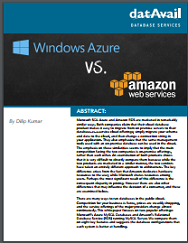Windows Azure vs. Amazon Web Services

Microsoft SQL Azure and Amazon RDS are marketed in remarkably similar ways. Both companies claim that their cloud database product makes it easy to migrate from on premise servers to their database-as-a-service cloud offerings; simply migrate your schema and data to the cloud, and then change a connection string in your application. They also emphasize that the same management tools used with an on premise database can be used in the cloud. The emphasis on these similarities seems to imply that the main competition facing the two companies is on-premise offerings, rather than each other. An examination of both products shows that it is very difficult to directly compare them because while the two products are marketed in a similar manner, the two vendors have taken an entirely different approach to architecture. The key difference arises from the fact that Amazon dedicates hardware resources to the user, while Microsoft shares resources among users. Perhaps the most significant result of this difference is the consequent disparity in pricing. However there are also other differences that may influence the decision of a consumer, and these are examined below.
There are many ways to run databases in the public cloud. Competition for your business is fierce, prices are steadily dropping, and the service offerings of the major providers change almost continuously. This whitepaper focuses on two popular offerings: Microsoft’s Azure MySQL Databases and Amazon’s Relational Database Service (RDS) running MySQL Server. We compare them on eight key features and suggests the database configurations that each system is better at handling.

